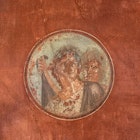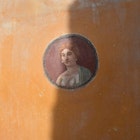
Feb 17, 2022 • 3 min read

Jan 12, 2023 • 4 min read

House of the Vettii or Casa dei Vetti has reopened to the public this week following a massive restoration project © Marco Cantile/LightRocket/Getty Images
After being buried under rubble for nearly two millennia, Pompeii's House of the Vettii has reopened to the public following 20 years of restoration work.
Like most of Pompeii's famous townhouses, House of the Vettii, or Casa dei Vettii, was found in remarkably good condition when it was first discovered in the late 19th century. Richly decorated with impeccably preserved frescoes — including the Cupid Rooms, which reveal a 15cm-high frieze of cupids preparing for a banquet — the house is considered one of the most outstanding examples of first-century Roman art.
Although the house partially opened in 2016, it closed again in 2020 to allow for complete restoration work before finally reopening on January 9. It offers visitors a glimpse of Ancient Roman life in the corner of Italy frozen in time after Mount Vesuvius's eruption in 79 AD.

Casa dei Vettii can be found in one of the wealthiest parts of Pompeii and is named after its owners: two formerly enslaved men known as Alus Vettius Restitutus and Aulus Vettius Conviva. When freed, the men had become wealthy merchants, making their fortune in the Mediterranean wine trade and using their wealth to decorate their homes with elaborate art and entertaining the local elite.
Pompeii: get to know Italy's legendary ruined city
In addition to the Cupid Rooms, visitors will see bronze and marble statues inside the home, planted gardens, marble fountains, and walls and walls of extravagant art depicting sacrifices, hunts, erotic scenes and Greek mythology.
One of its most famous frescoes is right by the doorway to the house and depicts Priapus, the Greek god of fertility, weighing his gigantic penis on a set of scales leaning against a bag of money. An image that was likely supposed to symbolize the owners' wealth and perhaps to impress (or intimidate) the neighbors.

Another room, near the kitchen, is decorated with graphic erotic wall art and archaeologists believe this room would have been used as a brothel, something that was common in the homes of the elite at the time, as prostitution was permitted both socially and legally in Pompeii. Although the images depicted on the walls of the brothels are often sensual and alluring, the sex workers of Pompeii were enslaved people.
An inscription discovered on a wall gives the name of the enslaved person who worked here in Casa dei Vetti, Eutychis, describing her as a "Greek of beautiful manners" alongside an engraving that lists her services, ranging from one to 16 asses (a local currency).
See another side of Pompeii as an exhibition of erotic art opens to the public

"The House of the Vetti is like the history of Pompeii and actually of Roman society within one house," Pompeii's director, Gabriel Zuchtriegel, told the Associated Press, and later described the house as the "the Sistine Chapel of Pompeii".
"We're seeing here the last phase of the Pompeian wall painting with incredible details, so you can stand before these images for hours and still discover new details," he added ahead of Tuesday's reopening.

The reopening of Casa dei Vettii is part of a broader €155 million ($137 million) restoration projected largely financed by the European Union. Named the Great Pompeii Project, the multiyear effort aims to prevent further deterioration at the ancient Roman site and continues to uncover new treasures.
Recent restoration projects include the Villa dei Misteri or Villa of the Mysteries, a large suburban villa located on the outskirts of Pompeii, and the House of Lovers, named after an inscription on the house which read: "Amantes ut apes vitam melitam exigent. (Lovers, like bees, make a life as sweet as honey)." The House of Lovers was first excavated in 1923, and most of its decorations were found almost entirely intact. It reopened to visitors during the pandemic after closing more than 40 years ago following earthquake damage.
The best things to do in Naples: livin' la dolce vita

Pompeii Archaeological Park is open from 9am until 5pm from November 1 through March 31; the last entry is at 3:30pm. From April 3 to October 31, it opens from 9am until 7pm, with the last admission at 5:30pm. General adult entrance costs €18. Entrance tickets can be purchased online at TicketOne.

Art and Culture
Visiting Pompeii in 2023? Exciting discoveries reveal new truths about the doomed cityMar 17, 2023 • 6 min read

Feb 17, 2022 • 3 min read



Jan 4, 2021 • 2 min read



Feb 19, 2020 • 2 min read

Oct 24, 2019 • 2 min read

Oct 22, 2018 • 2 min read